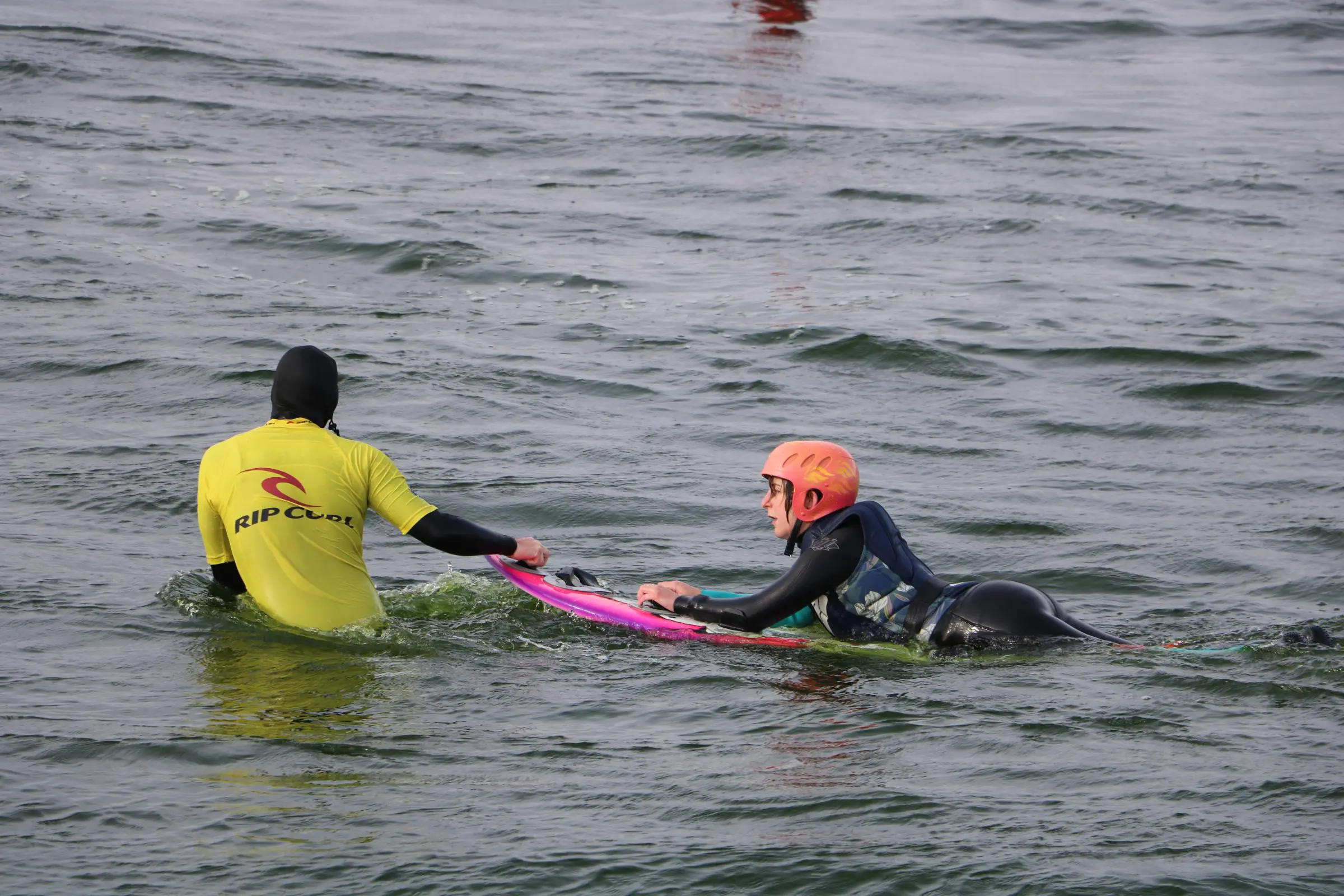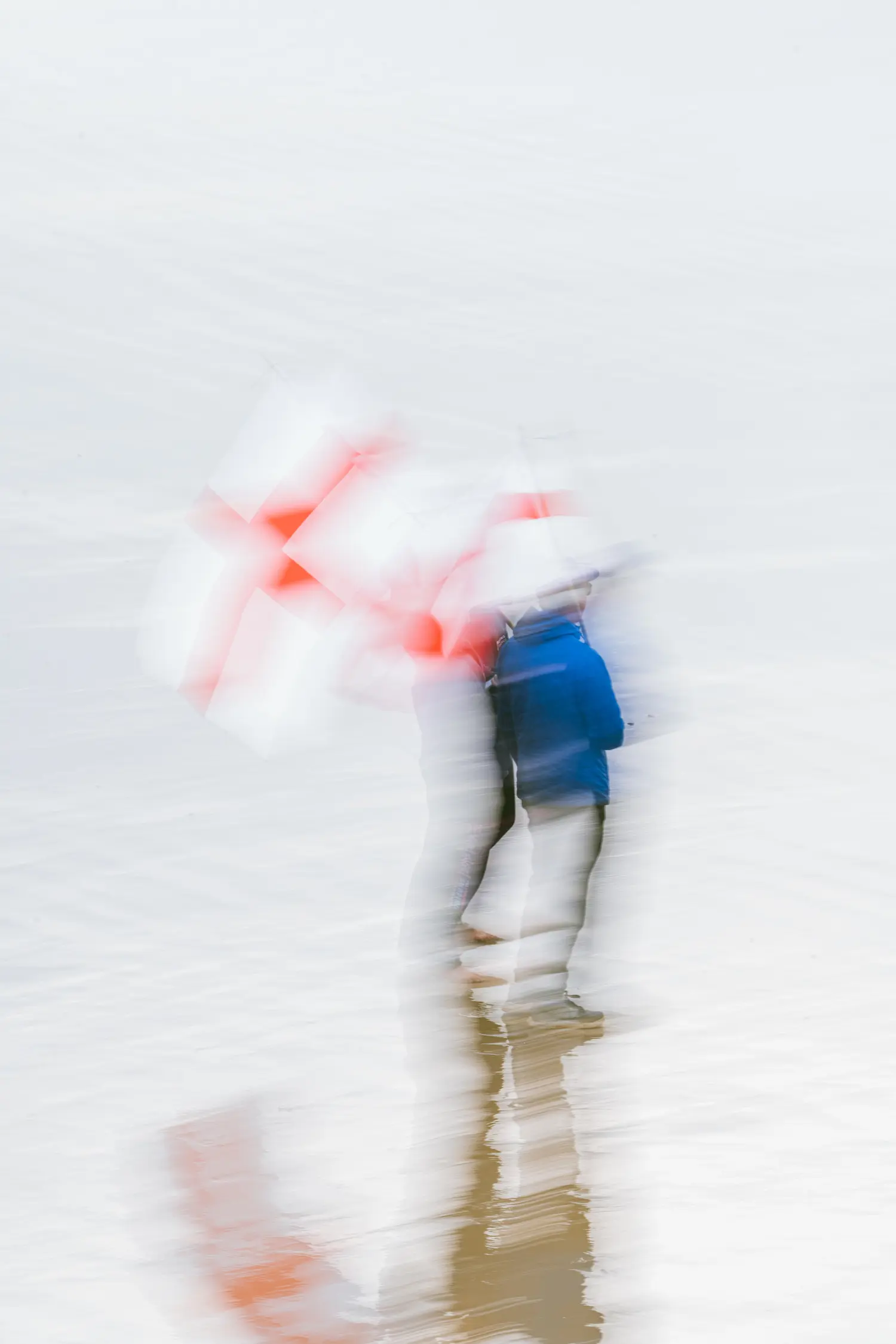Hannah Dines: Adventures In Para Surfing
In 2022, Hannah Dines set the goal once again to compete internationally as a prone surfer. In this article Hannah talks about what para surfing is to her, the challenges of getting to the World championships and the experience of competing at Pismo beach last month. There’s a flourishing community of competitive adaptive athletes around the globe currently and it’s going to be very exciting to see what 2023 brings for them and the sport.
Words by Hannah Dines
Hannah’s Adventures in Para surfing Land: Journey To The World Champs
I’m Hannah Dines and I compete for Team England in the prone assist division of para surfing. My kick-ass, gripped out board? That’s by SurfDek.
My 2022 Journey To The World Championships
Prone surfers do it like that one kid who goes headfirst down the waterslide, on our fronts. I compete with two other able-bodied athletes alongside me. I have someone who pushes me into decent looking waves (human jetski?). Then I ride the wave, that’s all me and back to a second person who guides me in, at the shoreline. Prone surfers are like bodyboarders but our boards are hard, support our legs and can go much faster. The sports’ terminology is pushers and catchers. My teammate Andy, who’s new to surfing, forgot that during training one time and referred to them as “my launcher and dragger…or whatever they’re called” and it was brilliant and what they should have been called all along.
My aim for 2022 was to qualify for the World Championships in Pismo Beach, California. The twin aim (I always have two, if one fails you always have the other to fall back on) was developing young pushers and catchers who had never been to an international competition before. The basic barrier for me to participate in this sport is a lack of trained surf coaches and a belief that anyone can step in to assist in competition. It’s a dangerous illusion. Your pusher and catcher become extensions of your own body and if you’ve only just met them or don’t work well together, or they’re not fit enough, it can be a frustrating, if not a frightening experience.
Working with a team consistently to build trust and coping strategies, endurance, as well as that “one-body” feel means you can take on almost any type of surf. I’ve surfed huge sets and challenged myself beyond belief and it has all felt so natural.




I had spent January, hitting up old contacts and laying my dreams out at the feet of expert surfers. Two surfers were able to commit their and energy to my goals and so we set about working together every month. I was able to take them two international competitions to prepare, to understand what would be involved and to support them to make an informed decision about competing with me at the World Champs. In July we competed at the English Nationals and I came out 2nd place in the mixed division of maybe twelve competitors and first woman. It was rush, we surfed well and I knew I’d qualified. SurfDek were watching too, little did I know they had watched and started to create the world’s first soft deck handles and leg-fenders. In fact, they never stop innovating and have many other products now.
Despite securing my spot and decking out my board in the most fabulous way with SurfDek, the plan did not run smoothly. Sporting plans rarely do. Finn, my catcher, decided he wanted to change careers entirely and stop focusing on surfing and change to more land-based therapies. It was a loss but he let us know with plenty of time to go before Worlds. There was little stress and showed me what first competitions are for, to see if you like it or not. After that first comp (Spain, Pantin Classic) catcher Tom Barber became laser focused and really started coming into his own.


Seren, who is the head coordinator at my surf school (Surfability UK CIC) and who had been a firm no to competition due to anxiety, started to train as replacement catcher. So, we took her along to the second smaller international meet in Perros-Guirec, in Brittany. Shout to SurfDek’s Russell who drove us. She was incredible. Back home in Swansea keeping her brain and reaction response in mind, she upped the stress while surfing. Out sea swimming one day an old man, strolling through the dawn with his dog, yelped in surprise. “Sorry,” he said to her “I thought you were a mermaid”. That’s my hidden gem Seren Dixon!
Meanwhile I got very ill, twice. My health got so bad I worried I might not make it, surfing or anywhere at all. Tom aggravated an existing shoulder injury a month before we were meant to fly out and couldn’t train with me. Seren just kept getting stronger. I never once doubted I’d make it to California.
The Pismo Beach ISA World Para Championships
Then, glad I’d held my nerve and my health stable, we were all okay and in America. The surf was so big the first day we couldn’t go in. We tried the next day and had too many wipe outs to count. Throughout, Tom and Seren were calm and supportive, thoughtful every day. They didn’t just compete with me in the sea either, they provided one of the best pre-competition environments I’ve had, ever. I was recently diagnosed with coeliac disease, along with everything else, so they helped me keep to my new gluten-free diet as well as their vegan one. We were just a Welsh-English crew of three taking turns to cook and sitting down to eat our highly restrictive dinner every night in the USA. I’d got a tiny, pre-fab apartment with a two-person sofa but we’d squeeze in beside one another with microwave popcorn and Pirates of the Caribbean. I never made it more than 15 minutes before drifting off. I think I dribbled on one of them because they started taking in turns to sit on the floor the nights after (it took us 4 tries to finish off the first PoTC).
Competition day came and all the wave energy had died meaning only big, wide boards could catch and hold such weak surf. I have one, high wave power board and it just didn’t cut it. In general athletes need two boards; for high wave power and low. You should never blame your equipment alone, though. I truly didn’t feel connected to the sea as much as I normally do and I think it was because our training in the lead up took a hit. Still, it’s hard to feel morose even in a cold part of California, the sky is a resilient bright blue and the dolphins surf by your side.


We did our best and held 8th place but had to get through an identical second heat, where all athletes got a second chance to improve their scores. There was no wave energy again. Pancake waves. Still, Tom kept smiling at me and keeping my spirits up. Seren, too was poised and ready, she ran like lightening to drag me outback from the shoreline. It went as smoothly as it could have. I improved my wave scores from the first round but it wasn’t enough. I was heat 2 out of 4 and I watched as I got knocked out of the top eight, place by place.
It was frustrating and I hid in a restricted area so Tom and Seren couldn’t see me cry. Of course, I had the car keys and so they found me- I’d locked their boards in car and boy did they need a surf to drown their sorrows. Still my love for surfing stayed strong. You are never able to forget that para surfing, at least 2022 is fundamentally a kind sport. The next day, when we got back in for a free surf I swapped boards with a Swiss girl who didn’t make it either. Primarily I did wanted her to experience my deck grip handles and leg stoppers (fenders) and she loved them. The next day, the brother of Sarah Almagro, placed top three in the world, asked if he could surf with me. Alejandro started to coach me like he does with his sister. He’s nineteen and studying robotics. His sister lost all her limbs to meningitis four years ago and he’s studying to be able to build arms and legs for people like her. He’s also an excellent surfer. I learnt more that day than I had in a year.
I kept on having incredibly kind experiences with athletes from around the world and soaking up everything I could, like an over-eager sea sponge. No, I didn’t bring a medal home for England this year but I was insistent that I’d bring home the shared knowledge within this surfing community.

An empty fishtank sits on the podium at the opening ceremony. Large empty jars get loaned out to each nation and when filled with wet sand can seem like needless weight to lug halfway round the world. The commitment becomes clear when you see the finished product and get to have your local break called out to all. There’s a flag bearer and a sand pourer and layer by layer, flag by flag we map the world. Golden sand from Pinamar in Argentina lays down the first layer, then Umina beach, New South Wales in Australia. Other nations lay down theirs: black from Playa Hermosa in Costa Rica, more volcanic still is El Salvador’s Playa el Cocal, grey from Jamnesia beach in Jamaica. There’s golden and butter and bright white and beige and little bronze pebbles and back to black.
The joke goes that our sand pourer, Team England’s Mark Hagger, took his out his kid’s sandpit, not Bournemouth beach. I wonder at the heritage of the sand from Einsbach, a landlocked part of Germany with no coastline and I suspect it to be from one of the Canary Islands where their sand pourer lives, full-time. The Cheque Republic has sand from Taylor’s Mistake in New Zealand. We may not all be children of the sea but one way or another we’ve been drawn to it, ducks to water or sand to a fishtank in the middle of the concrete parking lot in Pismo Beach California.
It sits there, full, in the closing ceremony after the medals go home with the athletes. The world spins madly on, defined by small slivers of coastline where disabled surfers exist and surf. With twenty-eight layers in the fishtank, it’s the most beautiful symbol of our surfing community. One that is bigger and more full than ever before. Really grateful to be a single grain in that layer of sand in the fishtank, thankyou life.



